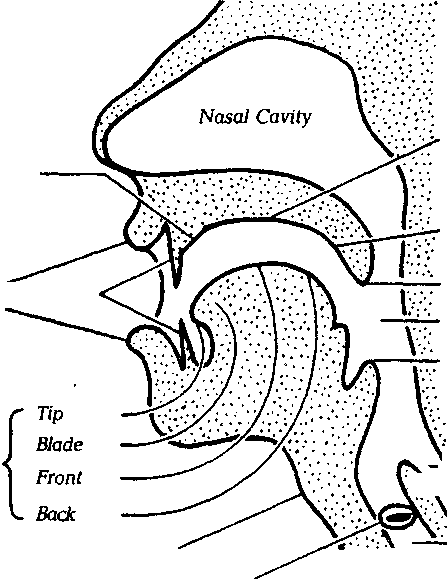
- •Міністерство освіти і науки України
- •2. Stylistic Use of Intonation
- •Check yourself
- •Now make sure that you can speak on these items:
- •Sounds and phonemes
- •Vowels and consonants
- •Check yourself
- •Now make sure that you can speak on these items:
- •Check yourself
- •Intonation
- •Intonation
- •Principles of classification
- •Main Principles of Classification of Consonants
- •Classification of English Noise Consonants According to the Degree of Noise
- •Table 3 Classification of the English Noise Consonants and Sonorants According to the Manner of Articulation
- •Check yourself
- •Intonation
- •Check yourself
- •Check yourself
- •Check yourself
- •Check yourself
- •Check yourself
- •Check yourself
- •Check yourself
Міністерство освіти і науки України
НАЦІОНАЛЬНИЙ ГІРНИЧИЙ УНІВЕРСИТЕТ


ФАКУЛЬТЕТ МЕНЕДЖМЕНТУ
Кафедра психології менеджменту та мовної підготовки
МЕТОДИЧНІ РЕКОМЕНДАЦІЇ
для практичних занять з дисципліни
«Практичний курс англійської мови»
(вступний фонетичний курс)
для студентів напряму підготовки
0305 Філологія

Дніпропетровськ
2005
Методичні рекомендації для практичний занять з дисципліни «Практичний курс англійської мови» (вступний фонетичний курс) для студентів напряму підготовки 0305 Філологія / Упорядник: Т.М. Висоцька. – Дніпропетровськ: Національний гірничий університет, 2005.
Упорядник:
Т.М. Висоцька, ст. викладач
Подано методичні рекомендації для практичних занять з дисципліни «Практичний курс англійської мови» (вступний фонетичний курс) для студентів напряму підготовки 0305 Філологія освітньо-кваліфікаційної програми підготовки фахівців спеціальності 6.030500 Переклад.
Рекомендовано до видання Навчально-методичним управлінням НГУ.
CONTENTS
LESSON 1. THE PRODUCTION OF SPEECH. THE SOUNDS OF SPEECH ……… 7
The Organs of Speech and Their Work
Sounds and Phonemes
Vowels and Consonants
LESSON 2. SOUNDS IN THE FLOW OF SPEECH……………………………….13
Sounds in the Flow of Speech
Assimilation
Syllable Structure
Word-stress
LESSON 3. CONNECTED SPEECH ……………………………………………..21
Intonation
Rhythm
LESSON4. CONSONANTS ………………………………………………...……23
Principles of Classification
Classification of Consonants on the Degree of Noise
Classification of Consonants on the Manner
of Articulation
4. Classification of Consonants on the Place
of Articulation
LESSON 5. INTONATION ………………………………………………………34
The Linguistic Function of Intonation
The Structure of Intonation Patterns
Classification of Intonation Patterns
LESSON 6. VOWELS …………………………………………………………...38
Principles of Classification
LESSON 7. REDUCTION …………………………………………………………………43
The Phenomenon of Reduction
Types of Reduction
LESSON 8. ASSIMILATION …………………………………………………….46
LESSON 9. PHONOSTYLISTICS ………………………………………………..48
General Considerations on Phonostylistics
2. Stylistic Use of Intonation
LESSON I
THE PRODUCTION OF SPEECH
THE SOUNDS OF SPEECH
The organs of speech and their work
Sounds and phonemes
Vowels and consonants
THE ORGANS OF SPEECH AND THEIR WORK
K ey
words and expressions:
ey
words and expressions:
organs of speech, air stream, the lungs, the windpipe, the larynx, the vocal cords, the glottis, to vibrate, voice, voiceless, glottal stop, the pharynx, the pharyngal cavity, the mouth cavity, the nose cavity, the uvula, the hard palate, the soft palate, the teeth ridge, the alveolar ridge, the tongue-tip, speech sound, tongue, the back of the tongue, the front of the tongue, the blade of the tongue, the tip of the tongue, rims, the lips, neutral position, rounded position, protruded forward position, active organs of speech, passive organs of speech
Hard Palate
Tongue
Fig. 1
Lips Teeth
Soft Palate
Uvula
Pharynx
Epiglottis
Trachea
Larynx
Vocal Cords

Alveolar
Ridge
In any language people speak (if they have no physical defects) using their organs of speech (Fig. 1). The air stream released by the lungs goes through the windpipe and comes to the larynx, which contains the vocal cords. The vocal cords are two elastic folds which may be kept apart or brought together. The opening between them is called the glottis. This is the usual state of the vocal cords, when we breathe out. If the tense vocal cords are brought together, the air stream forcing an opening makes them vibrate and we hear some voice. Let us pronounce the Ukrainian sound [з]. Put your finger on the larynx and produce a long [з] sound. You will feel the vibration of the vocal cords and hear voice. Such sounds are called voiced. Now produce a long Ukrainian sound [c]. No vibration is felt, no voice is heard. This is a voiceless sound, which is made with the vocal cords kept apart.
There is one more state of the vocal cords which results in the glottal stop. When the vocal cords are brought close together and then opened suddenly by the air stream there comes a sort of coughing noise, a kind of the 'click' of the vocal cords. This sound is called the glottal stop.
On coming out of the larynx the air stream passes through the pharynx.
The pharyngal cavity extends from the top of the larynx to the soft palate, which directs the air stream either to the mouth or nasal cavities, which function as the principal resonators.
The
soft palate can be easily seen in a hand mirror. Now open
your mouth wide and say the vowel [a]. Looking into the mirror
you will see the soft palate, the very end of which is known
as the
uvula.
The soft palate can easily move. When the
soft palate is in its lowered position the air goes up into the nasal
cavity and then out through the nose. This is the usual position
of the soft palate when we breathe through the nose. This is
also the position for the nasal sounds
![]()
![]()
![]() ,
,
![]()
![]()
![]() ,
,![]()
![]()
![]() ;
[м,
м',
н,
н'].
If
you
nip your nose you cannot pronounce these sounds. But as soon
as you release the nose the air will continue its way and you will
hear the sounds again. When the soft palate is raised the
uvula forms a full contact with the back wall of the pharynx and
the air stream goes through the mouth cavity. This is the most
typical position of the soft palate for most of the sounds of many
languages.
;
[м,
м',
н,
н'].
If
you
nip your nose you cannot pronounce these sounds. But as soon
as you release the nose the air will continue its way and you will
hear the sounds again. When the soft palate is raised the
uvula forms a full contact with the back wall of the pharynx and
the air stream goes through the mouth cavity. This is the most
typical position of the soft palate for most of the sounds of many
languages.
The soft palate is the furthest part of the palate from the teeth. Most of the palate is hard. This hard and fixed part of the palate is divided into two sections: the hard palate (the highest part of the palate) and the teeth ridge or alveolar ridge (the part immediately behind the upper front teeth). You can touch the teeth ridge with the tongue-t i p. The teeth ridge is very important in English as many consonants are formed with the tongue touching or close to it. If you still move the tip of the tongue forward you will feel the teeth.
The lower teeth are not very important for making speech sounds, while the upper teeth take part in the production оf many of them.
The most important organ of speech is the tongue. Phoneticians divide the tongue into four sections: the part which lies opposite the soft palate is called the back of the tongue; the part facing the hard palate is called the front; the one lying under the teeth ridge is known as the blade and its extremity the tip. By the central part of the tongue we mean the area where the front and back meet. The edges of the tongue are known as the rims. The tongue may lie flat or move in the horizontal or vertical directions. It can also change its shape so that the sides are curved up forming a groove.
The lips can take up various positions as well. They can be brought firmly together or kept apart neutral, rounded, or protruded forward.
All the organs of speech can be divided into two groups:
Active organs of speech, movable and taking an active part in the sound formation:
the vocal cords which produce voice;
the tongue which is the most flexible, movable organ;
the lips affecting very considerably the shape of the mouth cavity;
the soft palate with the uvula, directing the stream of air either to the mouth or to the nasal cavity;
the back wall of the pharynx contracted for some sounds;
the lower jaw which movement controls the gap between the teeth and also the disposition of the lips;
the lungs providing air for sounds;
Passive organs of speech:
the teeth;
the teeth ridge;
the hard palate;
the walls of the resonators.
